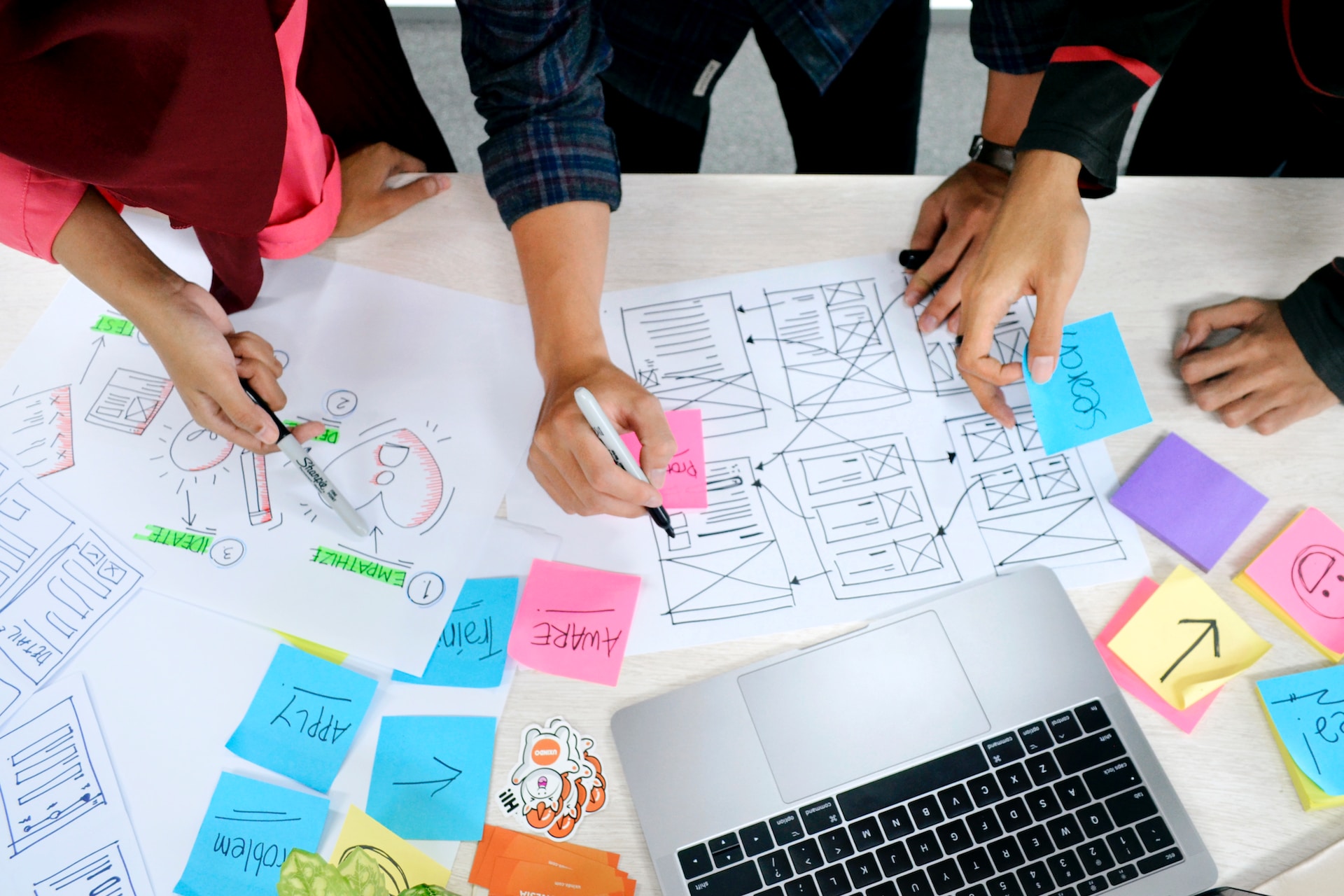Markets abhor a void, and sometimes your development team or company is faced with presenting a working solution to a fresh need almost on the go. Luckily, there is a product design sprint methodology that allows your team to answer complex business questions in a surprisingly short time.
What Is The Design Sprint Process?
The design sprint process is a proven process for solving problems quickly and developing innovative products. It was developed by Jake Knapp at Google Ventures and is now widely used by leading companies around the world.
The process involves a team working together intensively over a set period of time to define, design, prototype, and test a solution.
Agile Sprint Planning VS Product Design Sprint Process
Agile sprints and design sprints are two distinct approaches to managing projects and solving problems.
Agile sprints are frequently used in software development and revolve around the principles of the Agile methodology. They consist of brief, predetermined time periods during which a development team focuses on accomplishing a specific amount of work. The emphasis is on iterative development and gradual enhancement.
On the other hand, design sprints are a structured problem-solving process used to address specific design challenges and create innovative solutions. Design sprints typically span a few days and involve cross-functional collaboration. While both approaches promote iterative work, the key difference lies in their objectives and application.
Agile sprints primarily focus on software development and project management, while design sprints aim to solve design problems and create user-centered solutions.
How Long Does A Product Design Sprint Take?
A typical product design sprint lasts for five consecutive days. Each day focuses on a specific goal and includes a series of exercises and activities designed to move the team closer to the desired outcome. However, it is important to note that the duration can be adjusted based on the specific needs and constraints of each project.
A sprint planning meeting usually takes a substantial portion of the first day. This initial planning phase generally lasts around 1 to 2 hours. The team meets to set goals, discuss problems, and align on outcomes for the design sprint. The planning meeting is concise yet comprehensive to prepare for subsequent phases efficiently.
The Benefits Of Running A Product Design Sprint
Running a product design sprint offers several benefits. Firstly, it improves time efficiency by condensing the entire design process into a focused sprint, allowing for valuable time to be saved. Additionally, it reduces risk by enabling quick testing and validation of ideas, ensuring that resources are not wasted on unproven concepts.
The sprint also promotes collaboration, as it brings together stakeholders from different disciplines, encouraging collaboration and cross-functional learning.
Furthermore, the sprint emphasizes user-centered design, prioritizing user needs and ensuring that the final product meets the expectations of the target audience.
Lastly, the sprint facilitates faster decision-making by providing a structured framework, minimizing delays and indecisiveness.
Design Sprint Phases In Detail
The product design sprint process consists of five distinct phases that guide the team from problem definition to validated prototype.
Understand
During the understanding phase, the team engages in several crucial activities. They begin by clearly defining the problem statement and establishing a comprehensive understanding of the issues at hand.
Through user research and insightful exploration of user stories, they collect valuable perspectives that shed light on user needs and expectations.
This phase also involves identifying pivotal challenges and constraints that might impact the project’s direction. Overall, the understanding phase sets the foundation for informed decision-making and effective planning as the sprint progresses.
Diverge
During the diverging phase, the focus shifts to generating a multitude of creative ideas. Team members engage in brainstorming sessions, pooling their collective insights to envision potential solutions to the identified problem.
This phase encourages free thinking and exploration of various angles and existing solutions. Sketches and storyboards are crafted to visualize these ideas, giving them a tangible form.
By exploring different approaches and possibilities, the sprint team also widens the range of potential solutions, fostering innovation and setting the stage for the subsequent phases of the sprint.
Decide
During the deciding phase of the sprint, the team takes the generated ideas from the previous phase and embarks on a process of careful evaluation and prioritization. This involves weighing the potential of each idea against set criteria and selecting the most promising ones.
With the chosen ideas in hand, a comprehensive plan is crafted for the upcoming stages of digital prototyping and testing.
This phase is also marked by the definition of the user journey, outlining the path target users will take through the product, discussing user flows and identifying the key features that need to be incorporated.
By making these critical decisions, the team lays a solid foundation for the subsequent development steps, ensuring a focused and effective continuation of the sprint.
Prototype
During the prototyping phase of a design sprint, the team transforms selected ideas into tangible and interactive representations. This involves the development of a high-fidelity prototype, either through digital tools or physical mock-ups, depending on the nature of the product.
The primary goal is to create a prototype that closely emulates the final product’s functionality and appearance.
Attention to detail is crucial to ensure that the prototype effectively captures the envisioned user experience and features. This phase serves as a bridge between concept and reality, allowing the team to collect valuable information through thorough testing and validation before proceeding to the final stages of product development.
Validate
During the validating phase of a sprint, the team shifts its focus to real-world testing. The developed prototype is subjected to a thorough evaluation, providing valuable insights into its usability and functionality for real users.
Through careful observation and systematic collection of user feedback, the team gains an understanding of how well the prototype aligns with user expectations and needs.
This feedback is then analyzed with precision, identifying areas that require further improvement and determining potential refinements. This iterative process of analysis of immediate feedback and adjustment allows the team to fine-tune the prototype based on the insights gleaned from more realistic interactions.
Ultimately, the validating phase plays a pivotal role in refining the product’s design and functionality, ensuring that it resonates effectively with its intended audience.
Basic Sprint Resources
The process of conducting a product design sprint can be incredibly fruitful, but only when the right resources are in place. Talking most generally, your team will need:
- A medium of choice. If you’re running a sprint offline, make sure you have whiteboards or large sheets of paper for visualizing ideas and collaborating and a bunch of post-it notes and markers for brainstorming and organizing thoughts. Otherwise, rely on some online software that is easily accessible to the entire team.
- The references. User personas and user journey maps to guide the design process. You will also later utilize testing materials such as interview scripts and observation sheets which will help you introduce direct feedback into the sprints.
- Digital tools. Don’t forget your design software or prototyping tools for creating high-fidelity prototypes of solutions.
Selected Methods And Project Tools
While every product design sprint may vary, some popular methods and project tools commonly used are:
- Crazy 8s: A fast-paced brainstorming exercise where participants sketch eight ideas in eight minutes.
- Storyboarding: Visualizing user interactions and scenarios through a series of sketches or illustrations.
- Rapid Prototyping: Using tools like InVision or Figma to quickly create interactive prototypes.
- Usability Testing: Conducting user tests to gather insights on the usability of the prototype.
Result For The End Of The Day
At the end of each day in a product design sprint, the team should have achieved specific outcomes. These outcomes may include a problem statement, divergent ideas, a selected solution, a high-fidelity prototype, or user feedback. Ensuring there is a valid sprint goal reached at the end of each day keeps it on track and provides a clear direction for the next steps.
By following the process and utilizing the various resources and tools available, a product design sprint can lead to the development of innovative, user-centered solutions in a short period of time.
If you want to fast-track your product development process, consider running a product design sprint and harness the power of collaboration, efficiency, and user story mapping.













 +1 (888)
413 3806
+1 (888)
413 3806